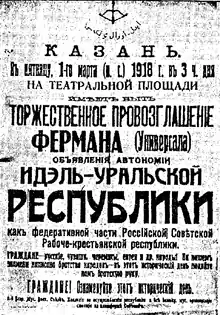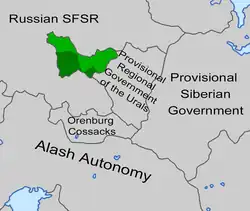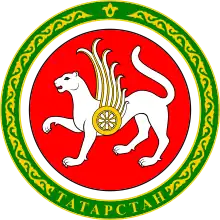Idel-Ural State
The Idel-Ural State (Tatar: Идел-Урал өлкәсе, İdel-Ural ölkäse, إِديل-اٗورال ئۈلكەسىٰ), also known as the Volga-Ural State or Idel-Ural Republic,[3] was a short-lived Tatar republic located in Kazan that claimed to unite Tatars, Bashkirs, Volga Germans, and the Chuvash in the turmoil of the Russian Civil War.[4] Often viewed as an attempt to recreate the Khanate of Kazan, the republic was proclaimed on 1 March 1918, by a Congress of Muslims from Russia's interior and Siberia.[5] Idel-Ural means "Volga-Ural" in the Tatar language.

Idel-Ural State Идел-Урал | |||||||||
|---|---|---|---|---|---|---|---|---|---|
| 1–28 March 1918 | |||||||||
 Flag | |||||||||
 Controlled territory in dark green, claimed in light green. | |||||||||
| Status | Unrecognized state | ||||||||
| Capital | Ufa | ||||||||
| Common languages | Tatar, Russian | ||||||||
| Government | Republic[1] | ||||||||
| President | |||||||||
• 1918 | Sadrí Maqsudí Arsal[2] | ||||||||
| Historical era | Russian Civil War | ||||||||
• Proclamation | 1 March 1918 | ||||||||
• Government in-exile | 1918 | ||||||||
• Defeat by Red Army | 28 March 1918 | ||||||||
| |||||||||
| History of Tatarstan |
|---|
 |
During the Russian Revolution, various regional political leaders convened in June 1917 in Kazan. The group declared the autonomy of "Muslim Turk-Tatars of Inner Russia and Siberia". Later on, in Ufa, a parliament named the Millät Mäclese (National Council) was created, in which a draft for the creation of the state would be pushed through and accepted on 29 November 1917 following the Second All-Russia Muslim Congress. However, the Idel-Ural State was met with opposition from Zeki Velidi Togan, a Bashkir revolutionary, who declared the autonomy of Bashkiria, as well as from the Bolsheviks, who had initially supported the creation of Idel-Ural but two months after denounced it as bourgeois nationalism[7][8]: 105 and declared the creation of the Tatar-Bashkir Soviet Socialist Republic, with around the same borders as Idel-Ural. This struggle between three different movements weakened the Idel-Ural State.[9]
Members of the Tatar-Bashkir Committee of Idel-Ural based outside of Russia such as Ayaz İshaki participated in an anti-Bolshevik propaganda war. Some also joined the Prometey group, a circle of anti-Soviet Muslim intellectuals based in Warsaw.[8]: 100 The idea of Idel-Ural by its supporting nationalists included the territory of modern-day Tatarstan, Bashkortostan, and most of Orenburg Oblast. The nationalists also wished for expansion towards the Caspian Sea. In January 1918, the Millät Mäclese adopted a constitution written by Galimzian Sharaf, Ilias and Jangir Alkin, Osman Tokumbetov and Y. Muzaffarov. The Millät Mäclese looked to declare the creation of Idel-Ural on 1 March 1918, a plan which never came to fruition due to Bolshevik arrests of members of the Millät Mäclese and their official declaration of the Tatar-Bashkir Soviet Socialist Republic.[8]: 105
The Republic, which in reality included only some sections of Kazan and Ufa, was defeated by the Red Army on 28 March 1918.[10][11][12] Its parliament disbanded in April.[9]
The president of Idel-Ural, Sadrí Maqsudí Arsal, escaped to Finland in 1918. He was well received by the Finnish foreign minister Carl Enckell, who remembered his valiant defence of the national self-determination and constitutional rights of Finland in the Russian Duma. The president-in-exile also met officials from Estonia before continuing in 1919 to Sweden, Germany and France, in a quest for Western support. Idel-Ural was listed among the "Captive Nations" in the Cold War-era public law (1959) of the United States.[13]
See also
Notes
- "Рожденный революцией. Татарскому парламенту исполнилось 100 лет". RFE/RL. 30 November 2017.
- "Почему не удалось построить Идель-Уральскую республику". RFE/RL. 4 August 2018.
- "Почему не удалось построить Идель-Уральскую республику". RFE/RL (in Russian). 4 August 2018. Retrieved 2020-12-25.
- Shamil, Said; İsxaqıy, Ğayaz (1932). Independence of the North Caucasus and the Idel-Ural state. Cairo: al-Maṭbaʻa as-Salafīya. OCLC 953833658.
In 1918, the Congress of Muslims from central Russia and Siberia founded the Idel-Ural State, also known as a Volga-Ural State, a short-lived independent state of Turkic peoples and Volga Germans.
- "Почему не удалось построить Идель-Уральскую республику". RFE/RL (in Russian). 4 August 2018. Retrieved 2020-12-25.
- "Милләт Мәҗлесен ачу тантанасы". Азатлык Радиосы (in Tatar). 9 January 2012. Retrieved 2022-07-25.
- IZMAIL I. SHARIFZHANOV (2007). "The parliament of Tatarstan, 1990–2005: vain hopes, or the Russian way towards parliamentary democracy in a regional dimension." Parliaments, Estates and Representation, 27:1, 239–250, DOI: 10.1080/02606755.2"007.9522264
- Yemelianova G.M. (2002) "Muslims under Soviet Rule: 1917–91." In: Russia and Islam. Studies in Russian and East European History and Society. Palgrave Macmillan, London. https://doi.org/10.1057/9780230288102_4
- Devlet, Nadir. "A struggle for independence in the Russian Federation: the case of the Tatars." In: CEMOTI, n°16, 1993. Istanbul – Oulan Bator: autonomisation, mouvements identitaires et construction du politique. pp. 63–82. Accessed 13 April 2021. https://doi.org/10.3406/cemot.1993.1052
- "Забулачная республика – взгляд через 85 лет". Казанские истории (in Russian). Retrieved 2020-12-25.
- Commissar and Mullah: Soviet-Muslim Policy from 1917 to 1924, Glenn L. Roberts, Universal-Publishers, 2007, p.178
- The New Central Asia: The Creation of Nations, Olivier Roy, I.B.Tauris, 2000, p.44
- Campbell, John Coert (1965). American Policy Toward Communist Eastern Europe: the Choices Ahead. University of Minnesota Press. p. 116. ISBN 0-8166-0345-6.
.JPG.webp)